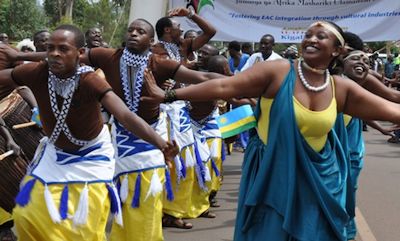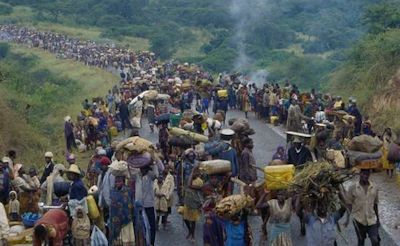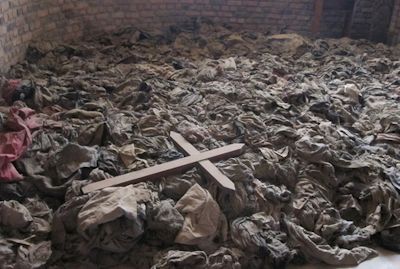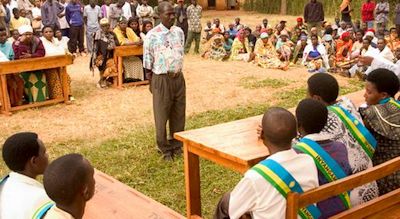Rwanda Safari
The Rwandan people, the 1994 genocide and the aftermath
 Rwanda is among the most visited countries on the African continent. Millions of people travel from all parts of the world not only to see the great wildlife including gorillas in the country but also to learn about the intriguing history and culture of this country while on their tour in Rwanda Back in 1994, Rwanda had a total population of over 7 million people with 3 main ethnic groups: the Twa who made up 1% of the population, the Hutu (85%) and the Tutsi (14%)
Rwanda is among the most visited countries on the African continent. Millions of people travel from all parts of the world not only to see the great wildlife including gorillas in the country but also to learn about the intriguing history and culture of this country while on their tour in Rwanda Back in 1994, Rwanda had a total population of over 7 million people with 3 main ethnic groups: the Twa who made up 1% of the population, the Hutu (85%) and the Tutsi (14%)
Before the colonial time, the Tutsis populated the higher level in Rwanda’s social system while the Hutus were lower in class. Nevertheless, social mobility happened, a Hutu who obtained a lot of cattle or any other kind of wealth could be taken into the group of the Tutsi and poor Tutsi would be considered as Hutu.
Ethnic Conflict Starts in Rwanda
In the late 1950’s as decolonization was taking its course, tension built up within Rwanda. The Hutu political motion, that stood to get from vast majority rule, was obtaining momentum whereas portions of the Tutsi faction opposed democratization as well as the loss of their attained privileges. However towards the end of 1959, a chaotic incident triggered a Hutu rebellion during which a large number of Tutsi were murdered and several thousands became homeless and ended up fleeing into the neighboring countries. This started the ‘Hutu Peasant Revolution’ also known as the ‘social revolution’ that started in1959 up to 1961, and actually represented the end of Tutsi control. By 1962, Rwanda attained its independence, approximately 120,000 people, mainly Tutsis, were refugees in the neighboring countries after running from the country to escape that violence.
However the Tutsi refugees within Tanzania and the then Zaire trying to gain back their previous positions within Rwanda started planning and staging several attacks on the Hutu government and hutu personalities. Between 1962 and 1967, each leading to murders of several Tutsi civilians within Rwanda and this created another large number of refugees. About 480,000 Rwandans had turned into refugees by the 1980s, especially in Uganda, Burundi, Tanzania and Zaire.
The Rwanda Civil War
A political & military movement the Rwandan Patriotic Front – RPF was started in Uganda in 1988, with the aim of getting freedom for the Rwanda people in exile and reform the government as well as share political power. The RPF included mainly Tutsi exiles living in Uganda, majority of whom had previously served in the National Resistance Army of President Yoweri Museveni that had over-thrown the 1986 Ugandan government.
started in Uganda in 1988, with the aim of getting freedom for the Rwanda people in exile and reform the government as well as share political power. The RPF included mainly Tutsi exiles living in Uganda, majority of whom had previously served in the National Resistance Army of President Yoweri Museveni that had over-thrown the 1986 Ugandan government.
In October 1990, about 7,000 fighters of the RPF made a huge attack on Rwanda from the neighboring Uganda. consequently, all Tutsis in Rwanda were labeled accomplices of RPF while Hutu people in the opposition parties were considered as traitors, and Media -radio, went on to spread unproven rumors that worsened ethnic problems.
In 1993, several governments within the east African region together with the Organization of African Unity (OAU) through their peacemaking efforts led to the signing of the Arusha-peace-agreements that seemed to put a stop to the conflicts between the Rwanda Government then dominated by the Hutu, and the opposition RPF Rwandan Patriotic Front. In 1993, during the month of October, the Security Council formed the United Nations Assistance Mission for Rwanda – UNAMIR with primarily roles of peacekeeping, offering humanitarian assistance as well as providing general support for the entire peace process within Rwanda.
However, right from the start, the necessity to attain as well as sustain peace was sabotaged by a number of political parties within Rwanda that were engaged in that Agreement. With the following delays within its implementation, there were more human rights violations and these became widely spread across the country consequently deteriorating Rwanda’s security situation. Soon after, evidence confirmed without a doubt that ‘rebel’ elements among mainly the Hutu although speaking of peace were in reality planning an operation to moderate the Hutus as well as get rid of the Tutsis.
The 1994 Rwanda Genocide
 In 1994, on 6th April, the Presidents of Rwanda and neighboring Burundi died in a plane crash as a result of being hit by a rocket attack. This ignited several weeks of extreme and organized mass murders. These killings (with an estimate of over one million people believed to have been killed) to the entire international community by surprise, and exhibited undoubtedly acts of genocide. In addition, between 150,000 and 250,000 women were said to have been raped. Persons in the presidential guard began killing the Tutsi civilians within a Kigali close to the airport. Just after the plain crash, in less than one hour; roadblocks operated by the Hutu militia-men and at times aided by gendarmerie (paramilitary police) or some military personnel were created to find the Tutsis.
In 1994, on 6th April, the Presidents of Rwanda and neighboring Burundi died in a plane crash as a result of being hit by a rocket attack. This ignited several weeks of extreme and organized mass murders. These killings (with an estimate of over one million people believed to have been killed) to the entire international community by surprise, and exhibited undoubtedly acts of genocide. In addition, between 150,000 and 250,000 women were said to have been raped. Persons in the presidential guard began killing the Tutsi civilians within a Kigali close to the airport. Just after the plain crash, in less than one hour; roadblocks operated by the Hutu militia-men and at times aided by gendarmerie (paramilitary police) or some military personnel were created to find the Tutsis.
The following day on 7th April 1994, a broadcast was aired by Radio Television Libres Des Mille Collines – RTLM revealing that the plane crash was caused by the RPF as well as a group of UN soldiers, in addition to provocation to get rid of the “Tutsi cockroach”. Sadly, Later that very day the Rwanda Prime Minister – Agathe Uwilingiyimana together with ten Belgian peacekeepers who had been allotted to guard her were all cruelly slain by the soldiers of the Rwandan government during an attack which they made on her home. Similarly a number of other moderate- Hutu politicians were killed. Following the bloody murder of some of the Belgium guard troop members, it withdrew its entire force. By 21st April, the UNAMIR force had reduced in size to just 270 from the initial 2165 following other countries also withdrawing their troops.
In case the lack of a firm commitment to peace and reconciliation by a number of the Rwanda political parties was a challenge, the disaster was worsened by the declining reaction of the international community. The United Nations’ ability to lessen human suffering within Rwanda was greatly limited by the Member States who were unwilling to respond to the circumstances in Rwanda through fortifying UNAMIR’s mission and contributing more troops.
On 22nd June 1994, the Security Council sanctioned forces led by the French to setup a humanitarian mission. That mission referred to as ‘Operation Turquoise’, saved a large number of civilians especially within Southwestern Rwanda, however is also believed have authorized soldiers, a number of officials as well as militiamen that took part of the genocide to escape from Rwanda through the regions under their control. In some other areas, murders continued right up until 4th July 1994 when the Rwandan Patriotic Front (RPF) gained control of the whole country.
The Aftermath of the 1994 Genocide
armed forces, Government officials and soldiers who had taken part in the genocide ran to the neighboring D.R Congo, at that time called Zaire, and took with them close to one and a half million civilians, the majority being Hutu that were informed that they would be killed by the RPF . Hundreds and hundreds of these passed away because of water-borne diseases. They established camps which the former government soldiers used to re-arm and launch attacks into Rwanda. These attacks are actually among the factors that led to wars between the D.R Congo and Rwanda in 1996. Today forces that served in the Rwandan government continue operations within the D.R Congo together with Congolese militia plus several groups of armed forces. They continue to attack civilian communities killing and injuring some of them.
At the end of 1994, the government of Rwanda started the long awaited genocide trials. The holdup was because Rwanda had lost the majority of its judicial staff, and also its court houses and jails had been destroyed. By the year 2000, more than 100,000 suspects from the genocide were awaiting trial. by 2001, the Rwanda government started implementing a participatory judicial system, referred to as Gacaca, so as to handle the large backlog of court cases. Different Communities elected their judges who would to hear the different trials of the genocide suspects that were accused of different crimes beside planning the genocide and raping women. The Gacaca courts have provisionally released the accused as they await trial. These releases have actually caused so much misery among the survivors that look at it as a kind of amnesty. Today, the Rwandan government is still using its national courts to try people who were involved in raping women as well as planning the genocide under the penal law. However these courts don’t offer any provisional release for any of the genocide offenders.
awaited genocide trials. The holdup was because Rwanda had lost the majority of its judicial staff, and also its court houses and jails had been destroyed. By the year 2000, more than 100,000 suspects from the genocide were awaiting trial. by 2001, the Rwanda government started implementing a participatory judicial system, referred to as Gacaca, so as to handle the large backlog of court cases. Different Communities elected their judges who would to hear the different trials of the genocide suspects that were accused of different crimes beside planning the genocide and raping women. The Gacaca courts have provisionally released the accused as they await trial. These releases have actually caused so much misery among the survivors that look at it as a kind of amnesty. Today, the Rwandan government is still using its national courts to try people who were involved in raping women as well as planning the genocide under the penal law. However these courts don’t offer any provisional release for any of the genocide offenders.
The Rwanda Gacaca courts generally give lower sentences in case the person is remorseful and looks for reconciliation with the native community. The Gacaca courts are meant to assist the community take part in the justice as well as reconciliation process of Rwanda.
On 8th November 1994, the Security Council established the International Criminal Tribunal for the Republic of Rwanda, presently headquartered in Arusha – Tanzania. In 1995, investigations started and the very first suspects were presented to court in the month of May 1996 and hearing of the first case started in 1997 in the month of January.
The UN Tribunal has a legal system over all the offenses of worldwide human rights that took place within Rwanda between the month of January and the month of December 1994. The Tribunal has the ability to take legal action against politicians and leaders that are even in high government ranks as well as high ranking members of armed forces who could have escaped from the country and would have gone without punishment. Since then, this court has convicted Jean Kambanda the then Prime Minister at the time of the genocide who was sentenced to life imprisonment. This was actually the very first worldwide court to condemn a suspect for a rape crime done against humanity during the genocide. This court went ahead and tried owner to 3 media houses who were charged with making use of their respective media to trigger ethnic hatred that resulted into the genocide. By 2007, judgment had been passed on to 27 of the 33 accused suspects.
For More information about the 1994 Genocide in Rwanda, take a tour in Rwanda and learn more about these genocides and also how people recovered from the genocide.
